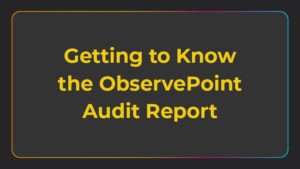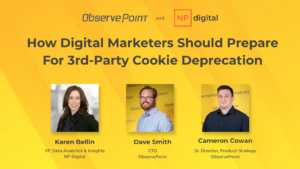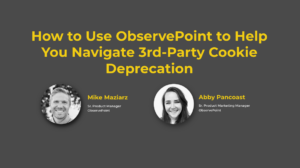
Web analytics puts out a siren call that has many digital professionals haphazardly directing their data strategy strategies towards choppy waters.
While there may seem to be little harm in a young entrepreneur quickly and carelessly deploying a free analytics solution on a website, this kind of approach can hardly be considered a strategy, and will lead right into a data whirlpool.
And this lack of data governance isn’t just an issue for first-time analytics users—professionals at enterprise organizations also fall into the trap of erratically deploying analytics without considering the “why” of their efforts. They end up with websites bloated with redundant, incomplete and inconsistent analytics deployments.
If there is no strategy to begin with, there is no way to map the data against any sort of tangible measurement of success. How then can you know if you’re accomplishing your objectives if you don’t know what they are?
A set-it-and-forget-it, quick-and-easy, I’m-doing-this-because-they-told-me-to approach misses the entire point of analytics. Before you deploy, start with the why.
The “Why” of Web Analytics
Understanding the “why” of your analytics starts with understanding the “why” of analytics in general.
Websites exist to sell more stuff. Forgive me for seeming brash for suggesting that all digital assets are in the game of selling you something, but it’s true. Even if your website is not an eCommerce site, you are likely trying to improve revenue by offering motivation to your customer base to engage with your products or services. For example:
- Financial services websites offer services online so that you’ll do more business with them
- Automobile companies try to redirect you to one of their dealers so you can buy their cars
- Restaurant websites entice you to try their food
- Media websites either sell their content or sell space to advertisers—or both
- Non-profit websites, such as for universities, present themselves as an institution worthy of your tuition, your donations, your volunteer time
No matter what the content is, the real objective is to sell merchandise, services or ideas. It is not content for content’s sake—there is an agenda to be fulfilled.
But websites and mobile apps are a bit of a black box: without some sort of technology to aggregate user behavior data, there is no way of mapping trends and measuring performance.
That’s the exact role analytics platforms fill: aggregating data, creating consumable, customizable dashboards and providing query-able data sets for discovering patterns. When applied correctly, analytics helps companies measure the extent to which they accomplish their objectives.
The “What” without the “Why”
The “why” of analytics teaches us that we should have some sort of success metric—some tangible concept of what it means to achieve our objectives—in order to understand our progress and identify the dead weight in our website that is causing drag.
But instead of starting with the “why,” it can be tempting to start with the “what,” both in the way you deploy your analytics as well as how you interpret the data.
A “what” approach asks “What vendor should we deploy?” A seemingly harmless question, but you need to be careful.
Focusing on the “what” could cause you to automatically default to the least expensive solution—free and easy—without considering your other options.
On the other hand, a “what” mentality could also cause you to get overly excited about the wide suite of features in enterprise-level analytics solutions—undoubtedly useful, but do you know how to use them? Is your analytics organization mature enough to employ the full feature set?
Those are the dangers of a “what” approach when choosing your technology.
What about after deployment?
Let’s consider the freemium, out-of-the-box option. Without any sort of established KPIs when going into your platform, what are you going to look at? Probably the information that is automatically fed to you. This means you will try to understand your website based on pre-defined generic metrics that are non-specific to your business objectives. While metrics like pageviews, new visitors and bounce rate give context to the user experience, they may or may not be very accurate reflections of revenue-driving activity.
Again, on the other end of the spectrum, with the super-fancy, high-profile, 1000-horsepower analytics platform, entering without specific goals likely means you will start looking at what you could do, instead of what you should. You’ll end up getting tangled up in complexity and actionable insights will be sparse.
So before you ever think about what to do, begin with the “why.”
Establishing a “Why”
Analytics is about optimizing the ease of engagement. It’s about figuring out what stands in prospects’ way of becoming profitable customers.
So ask yourself “Why do I have a website?”
Look at the reasons for your website. Why do you have it in the first place?
Is your website meant to sell merchandise, create brand awareness, send people to resellers, reduce employee workload with self-service? Is it meant to be a scalable form of customer service? Are you trying to generate leads, nurture leads or convert leads?
If you have a hard time figuring out the “why” of your website, just follow the money—in the end, how is your website going to make you money?
Document your “why.” These can be simple statements of what you are trying to accomplish with your website, and should be synonymous with the business requirements laid out when your website was developed.
For example, if you were hoping to implement web analytics on a customer support site for your SaaS company, your “why” statement might look something like this:
- Help customers easily locate help articles to answer their questions
- Provide easy access to real-time chat with a customer support representative
Once you define your main purpose for even having a website, then you’re in a position to create requirements for the analytics. These requirements outline the “what” you will be measuring, and they only come after the “why.”
Documenting Your What
If you’re going to ask a “what” question, the one you should be asking is “What do I want my website visitors to accomplish?”, as this is the answer to why you have a website, and will inform your measurement strategy.
Going back to the above example of the SaaS company, here is what they might want their customers to accomplish:
- Search for, find and read an article
- Locate the real-time chat feature and interact in real time to solve a problem
These are just rehashed versions of the above “why,” but they’re important in understanding measurement strategy. These can be translated into conversion KPIs:
- Successful article reads, measured by the ratio of visitors who used search bar feature, navigated into an article and selected “I found this article helpful” radio button
- Unsuccessful chat users, measured by the ratio of users who selected an issue category, used chat, then returned within 24 hours and selected the same issue category
Another potential use of web analytics would be to identify which articles are most frequently visited and build a FAQ page around those topics or promote these articles to the top of the featured list.
Best practice in documenting your “what” is to create a solution design reference (SDR), alternately known as a tagging plan or a variable strategy. It is essentially documentation of the the different conversion events and variables you have deployed using your analytics tool. You can learn more about SDRs in our blog post 7 Steps to Set Up Your Web Analytics Solution Design.
Live by the “Why”
If you’re hoping to be an analytics driven organization, having a clearly established “why,” along with a continuously documented measurement strategy, will help you garner insights worth acting upon, instead of just vanity metrics that only sort of inform you as to your performance.
You know why you own a business. Your website and web analytics strategy should reflect that 100% percent.





